Kashin class destroyers (1964)
 Project 61: 20 Missile Destroyers: Komsomolets Ukrainy, Soobrazitelny, Provorny, Odaryonny, Obraztsovy, Otvazhny, Steregushchy, Krasny Kavkaz, Reshitelny, Strogy, Smetlivy, Krasny Krym, Sposobny, Skory, Ognevoy, Stroyny, Slavny, Smyshlyony, Smely (ORP Warszawa).
Project 61: 20 Missile Destroyers: Komsomolets Ukrainy, Soobrazitelny, Provorny, Odaryonny, Obraztsovy, Otvazhny, Steregushchy, Krasny Kavkaz, Reshitelny, Strogy, Smetlivy, Krasny Krym, Sposobny, Skory, Ognevoy, Stroyny, Slavny, Smyshlyony, Smely (ORP Warszawa).
Project 61M: Sderzhanny
 Project 61E (Rajput class):
Project 61E (Rajput class):
INS Rajput, Rana, Ranjit, Ranvir, Ranvijay.
These were Soviet standard missile destroyers of the 1960s-1970s. Versatile and recoignisable as the last flush deck hulled, they were developed from 1956 to replace the old conventional Kotlin class destroyers. They were a new kind of ASW escort capable of hunting down the latest US nuclear submarines, and defend the fleet against modern jets at low altitude, offering a wide umbrella as well against anti-ship missiles. First large Soviet ships to use gas turbines, their design was finalized and approved by Admiral Gorshkov at the end of 1957, but construction of the first only started from 1962 in Zhdanov, with some of the others built at Nikolayev.
This was the time a very innovative design, with all equipment, sensors and weapons redesigned and adapted. The design went from 3,200 to 3,400 tonnes and their gas turbines obtained results that conventional high-pressure turbines failed to reach, with a longer life and more generated power plus a thermal signature cut by a new funnel exhaust cooler. Komsomolets Ukrainy was a prototype testing the M3 conventional turbines, reaching 35.5 knots and Prozorlivy even 39.75 knots.
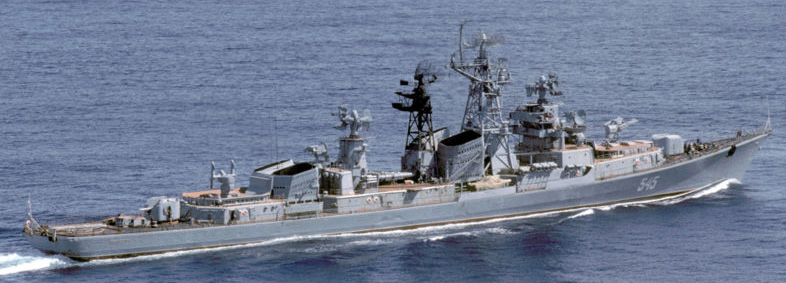
A Kashin in October 1985.
One paradox of these new gas turbines was their lower weight and compactness, which obliged to rethink stability, so the superstructures was thinned down as much as possible, which also contributing to reduce the radar signature overall. The Kashins were also the first with a well-though, comprehensive NBC and in particular nuclear and radiologic suite with detection, complete sealing and washing system, compartments with anti-radiation walls, including the bridge.
Zderzhanny, last of these twenty ships, was completed in 1973 to a different design and five early ships modernized to this new standard with 30mm gatling guns, new radars, EW suite, 4×16 Wympel decoys, 4 SSN-2c Styx cruising missiles, new sonar, variable depth sonar, rebuilt superstructures, and stern helideck, rebalanced displacement with 100t ballast and additional fuel tanks for a total of 4907 tons. Provornyy tested in 1974-76 the new SAN-7 nut remained the only one with this configuration.
Other of these destroyers were built later, with a tailored design for India, the Rajput class 1978-1985. They were discarded after the end of the cold war. One was lost by accident, Orel, ex-Otvazhnyy in 1974, and Smelyy was transferred in 1987 to Poland. Were striken in 1989 Ognevoy and in 1990 Oldarennyy, Provornyy and Stroynyy, in 1991 Slavnyy, Komsomolets Ukraini, in 1992Sobrazitelnyy, Sposobny, in 1993 Obraztsovyy, Steregushchiy, Smyshlennyy, Stroigiy, in 1995, Krasny Kavkaz, Reshitelnyy, Smetlivyy, Krasny Krim, Skoryy, and Sderzhannyy were still active,n but were discarded a few years later after some time in reserve, deteriorating. Only one survived to this day: The former Polish “Smely” which served until 2003 and in 2020 was withdrawn from the Polish Navy and was resold to Russia, then converted as a museum ship, now in Sevastopol.
Development
Context
The late 1950s and 1960s are a time of great change for the Soviet Navy, with new opportunities and new advanced weapons systems. This was primarily due the irruption of sea-based nuclear missiles, which turned submarines into strategic weapons. The appearance of SSBNs greatly increased their autonomy, cruising range, underwater speed and the level of threat they pose.
The second major threat was identified as the new generation of supersonic bombers and their long range cruise missiles, which could not be defeated by traditional anti-aircraft artillery systems.
To counter these new threats, active development of more effective SAMs and a new generation of long range weapons to destroy submarines led to design a carrier ship. In the US and depending on their specialization, these were called “fleet escort” (destroyers, frigates, cruisers or DD leader) while in USSR, all were called as “large anti-submarine ship” (RKR, большой противолодочный корабль).
This period of development saw the arrival of the first ballistic missile, still short ranged (200-300 kilometers) forcing SSBNs to come close to the enemy’s territorial seas or EEZ. Thus, anti-submarine search areas had to be pushed forward, well beyond the EEZ to defeat that important factor in strategic deterrence before long-range ballistic missiles arrived. Anti-submarine ships needed to hunt down these new nuclear powered SSBNs further into the ocean, for longer time, faster, and to provide a defensive screen for their own submarines deployed close to enemy’s waters.
In the USSR, the need for a new generation of specialized anti-submarine missile was realized in the late 1950s, and strategically it was decided to create a layered anti-submarine defense, where cruisers would operate out in the ocean in the outer bubble, carried out by helicopter carriers (Project 1123 Moskva), Kresta (and later Kara) class cruisers, and long range ASW patrol aircraft. In in the inner bubble and closer to territorial waters, smaller ASW destroyers were tasked of hunting down submarines, such as the Project 61 (Kashin) ships; and the thrid layer in and around immediate territorial waters, ASW Frigates (Poti, Petya, Mirka class for example).

Development History
Design of Project 61 started in 1956. According to early operational and tactical missions, its functions included fleet air defense both against jet aircraft and cruise missiles, and long/medium/close ranged anti-submarine defense. The development was entrusted to the Soviet state Institute of Military Shipbuilding.
During pre-draft process, the armament composition and its basic layout were determined. A linear, superfiring arrangement of air defense systems and gun mounts was adopted with one air defense system and one gun mount forward and stern. It was decided to place hydroacoustic systems internally, with retraction, to reduce draft and a better shaped fairing. At first anti-submarine missiles were excluded due to an increase of SAM load increased to 24 while standard displacement was calculated at 3,600 tons standard. When the definitive TTZ or tactical and technical specifications were approved, it was proposed for the powerplant to test a gas turbine engine. This option allowed a reduction of displacement of 400 tons, and was accepted. Thus, the future Kashin class became world’s first large combat ship with gas turbines.
After approval of the TTZ in early 1957, TsKB-53 under by B.I. Kupensky, started Project 61 preliminary design. It was was completed and approved in 1958, after which at ’61 Communards’ shipyard in Nikolaev planned construction of the lead ship by September 15, 1959. This was “Komsomol of Ukraine”. She was laid down and by December 31, 1960, launched, transferred to the fleet for state tests by October 15, 1962, and validate the class design. The test program was fully completed (except for full speed tests) due to a propulsion system still in the works. These were were postponed to 1963. It was also discovered that stability was left to be desrireed sue to the lighter powerplant, leading to create displacement reserves, but overall, given the novelty of these ship, the overall results were considered satisfactory at the time.
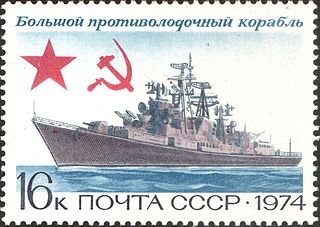 Defaults were ironed out such as insufficient reliability of the “Volna” air defense system and “Turel” artillery fire control system. The small radius of detection of of the ships hydroacoustic suite also meant using anti-submarine torpedoes and RBU-6000 launchers at their maximum range. Tests confirmed a generally good seaworthiness and later on trials a full speed maintained in heavy seas up to force 4-5, with good performance of pitch stabilizers. Top speed for the lead ship was 35.5 knots, and it was above 34 knots for all the others.
Defaults were ironed out such as insufficient reliability of the “Volna” air defense system and “Turel” artillery fire control system. The small radius of detection of of the ships hydroacoustic suite also meant using anti-submarine torpedoes and RBU-6000 launchers at their maximum range. Tests confirmed a generally good seaworthiness and later on trials a full speed maintained in heavy seas up to force 4-5, with good performance of pitch stabilizers. Top speed for the lead ship was 35.5 knots, and it was above 34 knots for all the others.
On December 31, 1962, after State Acceptance signed, the lead destroyer Komomolets Ukrainy, was accepted with the fleet and commissioned. In 1966, the design team behind the Kashin class (assigned by NATO when revealed) were awarded the Lenin Prize for their achievements.
Originally the Kashin class ships were classed as “patrol ships” (SKR) but on May 19, 1966, they were reclassified as large anti-submarine ships (LAS). Six were later converted under project 61-M/61-MP: “Restrained”, “Ognevoy”, “Glorious”, “Smely”, “Smyshleny” and “Stroyny”) and from 06/28/1977 reclassified as large missile ships (BRK) and back as LAS by October 14, 1980, the remaining shiops in 1993 reclassified as TFR.
Design of the class
Hull and general design
The Kashin’s hull was welded using SHL-4 (10HSND) steel, with a flush deck, prow twice higher than the stern, a characteristic rise of the upper deck, clipper bow and sloped stem with a lot of flare. To ensure high speed her underbelly was refined in hydaulic testings and had very sharp contours with a favourable length to width ratio of 9.5. The internals were subdivided into 14 compartments divided by watertight bulkheads and she had a double bottom over 80% oher length.
For the first time she was designed to be almost remotelly operated after a massive nuclear attack. She could still manage to conduct combat operations without presence of personnel on the upper deck and bridges, as consoles existed in a few completely sealed rooms with anti-radiation spall liner and air filters to increase survivability. Personal in the bridge had access to this secondary command post cia corridor in the superstructure and there were closed passage to combat posts, gas-tight vestibules as well as no portholes where it mattered. The main command post was indeed located on the lower deck, separately from the navigation post with all the displays to con,tinue man the ship, communicate with the engine room and use weapons systems as well as monitoring the situation based on radar data.
The Kashin class had a 90-meter long superstructure with two masts, two bases for antenna posts (Yatagan fire control system) and two twin funnels, which was also new. The exceptionally large size of these exhausts, reduced temperature of the exhaust gases and reduced thermal signature, making it possible also to replace the the entire propulsion system via hatches. To reduce displacement and improve stability, the superstructure, masts and funnels were all made of aluminum-magnesium alloys. Fire safety was not a concerned at the time. Masts bases, launchers, antenna posts and running post were made of steel however.

Powerplant
From the very origin of the design, two machinery options were considered, traditional steam turbine or gas turbine. The latter was lighter and more compact with a specific power to weight ratio of 5.2 kg/hp versus 9 kg/hp. They reduced the ship’s overall displacement by 400 tons and thus increased efficiency across the board. In addition they were much faster to run, going from cold to full power under 5-10 minutes compared to several hours for a classic steam turbine. Despite being untested as that scale, the option of gas turbine was adopted.
The sailors which proudly served on board soon called them the “singing frigates” due to the unusual, almost the melodious whistling of their gas turbines.
The bow and stern engine rooms occupied one compartment each, with a all-mode main gas turbine gear unit M-3 rated alone at 36,000 hp. They were manufactured by the Southern Turbine Plant in Nikolaev. They were coupled with two gas turbine generators GTU-6, 600 kW each (same manufacturer) and a single diesel generator DG-200/P rated for 200 kW. Compartments between them were occupied by auxiliary systems such as roll stabilizer and auxiliary boilers. All fuel ended in low-mounted double-bottom tanks offering 940 tons, as well as 70 tons of fresh water for the crew, 13 tons of water for the auxiliary boilers, in orde to add to the stability.
Total power was 72,000 hp. The gas turbine engines were rated for 18,000 hp each and they were mated on reversible gearboxes. Each engine had its own gas outlet pipe, and they were connected to two shafts ending with four-bladed fixed-pitch propellers.
The use of gas turbines required measures to reduce noise and there was a noise absorption system in the air intakes as well as shock absorption mountings and sound-absorbing coatings. The engines were controlled entirely remotely from a radiation-proof post located near its premises. The Kashin class had two Hall anchors and a semi-balanced steering wheel.
Armament

The armament was innovative as for the first time they were designed from the start as missile destroyers, with two anti-aircraft missile systems M-1 Volna, fore and aft. Each consisted of a two-beam ZIF-101 launcher assisted by a dedicated Yatagan control system and magazine below with two rotating drums, for 8 B-600 missiles each. The artillery comprised two twin 76-mm AK-726 turret mounts (90 rounds/min, range 13 km, alt. 9 km, 2400 rounds) assisted by two Turel fire control systems. They had a single five-tube torpedo tube PTA-53-61 firing the SET-53 or 53-57 torpedoes directed with the “Zummer” torpedo firing control system (Project 61MP: “Typhon”, enabling the SET-65 and 65K). In complement they had two RBU-6000 and RBU-1000 rocket launchers each with 192 RSL-60 and 48 RSL-10 reloads, contolled by the “Storm” control system.
Main: 2x M1 Volna (SAN-1 Goa)

The SA-N-1 ‘Goa’ surface-to-air missile launchers assorted with 32 missiles in store already were installed on cruisers, the Kresta I/II class and the .
The basic missile was the V-600 (or 4K90) with a range from 4 to 15 km, altitude from 0.1 to 10 km, guided by the 4R90 Yatagan radar with five parabolic antennas on a common head. Only one target can be engaged at a time.
On the Kashin, the improved ZIF-102, with a magazine for 32 missiles was used.
This ubiquitous system also called S-125 Neva/Pechora was largely exported.
⚙ specifications M1 Volna |
|
| Weight | 953 kg |
| Dimensions | 6,090 mm x 375 mm. wsp 2,200 mm |
| Propulsion | Solid propellant rocket motor |
| Speed | Mach 1 |
| Range | 35 kilometres (22 mi) |
| Guidance | RF CLOS |
| Ceiling | 18,000 metres (59,000 ft) |
| Payload | Frag-HE 60 kg, Proximity fuse |
Secondary: 2x twin AK-726 76 mm (3 in) guns
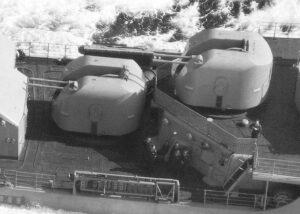 Development started in 1954 of a dual purpose twin gun, by TsKB-7 under Pyotr Tyurin. First tests started in 1958, onboard ships from 1960, 1962 installed on the Groznyy and then the lead ship of the Kashin class, Komsomolets Ukrainy. Official acceptance June 24, 1964. Also exported. Replaced by the AK-100. On the Kashins they were located forward and aft.
Development started in 1954 of a dual purpose twin gun, by TsKB-7 under Pyotr Tyurin. First tests started in 1958, onboard ships from 1960, 1962 installed on the Groznyy and then the lead ship of the Kashin class, Komsomolets Ukrainy. Official acceptance June 24, 1964. Also exported. Replaced by the AK-100. On the Kashins they were located forward and aft.
Projectiles hand-loaded into an elevator from the ammunition chamber, autoloader. Simultaneous fire, 100 rounds per minute on paper, 40 in reality due to excessive heat and dispersion issues. Both barrels were watercooled every few minutes after 40 to 45 rounds bursts (main water line).
Fire control via the MR-105 Turel (NATO Hawk Screech) or the semi-automatic Prisma optical sight, with manual backup. Use several types of HE ammunition, with contact and proximity fuzes.
⚙ specifications AK-726 |
|
| Weight | 26 t (26 long tons; 29 short tons) |
| Barrel lenght | 59 calibers, 76.2 mm (3 in), twin barrel |
| Elevation/Traverse | −10° to +85°, c300° |
| Loading system | Sliding wedge, automated |
| Muzzle velocity | 980 m/s (3,200 ft/s) |
| Range | Surface 15,700 m (17,200 yd), Ceiling 11,000 m (36,000 ft) |
| Guidance | |
| Crew | 9 |
| Round | 5.9 kg (13 lb) |
| Rate of Fire | 2× 40–45 RPM (80 rpm total) |
PTA-53-61 Torpedo Tubes
Installed aft of the mainmast, centerline, above the superstructure deck. Firing the SET-53 or 53-57 torpedoes.
⚙ specifications SET-53-57 TORPEDO (1957) |
|
| Weight | 4,409 lbs. (2,000 kg) |
| Dimensions | 299 in (7.600 m) |
| Propulsion | Kerosene-Hydrogen Peroxide Turbine |
| Range/speed setting | 19,700 yards (18,000 m) / 45 knots |
| Warhead | 672 lbs. (305 kg) |
| Guidance | Sonar guided, setup to target. |
Non-homing torpedo with an Engine based upon the German Stein-Butt torpedo of 1944.
Additionally, traditional mine rails and rear chutes preserved. In case these ships still could act as minelayers of needed.
Sensors
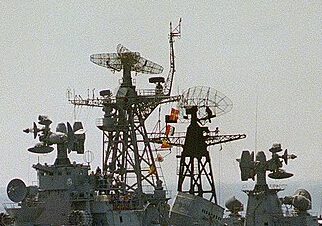 -MR-300 “Angara” air/surface search radars
-MR-300 “Angara” air/surface search radars
-ARP-50R radio direction finder
-MGK-335 Platina sonar (Project 61M)
-Planshet-61 Combat Information Control System
-Pult-61M Weapon FCS
-Titan all-round viewing station
-Vychegda fire control station (located in the under-keel fairing, detection range 3.5 km).
Protection
In addition to the many NBC protection measures taken and the external washing system, the ASW compartimentation with machinery separation, 15 compartment with bulkheads and full double double bottom, there were no armour provided, alsthough the radiation-proof Command Center had thicker walls to precisely defeat radiations, also capable of sustaining shrapnel damage. As for active protection, the Kashin class had two F-82-T launchers for firing passive radar reflectors. There was a protection against torpedoes by the towed guard BOKA-DU and demagnetization device.
Air Group
The ship provided storage for 5 tons of aviation fuel and ammunition for the Ka-25 anti-submarine helicopter (anti-submarine torpedoes, depth charges, sonobuoys), however, due to the lack of a hangar, only temporary deployment was possible.
⚙ specifications |
|
| Displacement | 3,400 tons standard, 4,390 tons full load |
| Dimensions | 144 x 15.8 x 4.6m (472 ft x 52 x 15 ft) |
| Propulsion | 2× shafts COGAG, 4× M8E gas turbines M3 72-96,000 hp (54-72,000 kW) |
| Speed | 38 kn (70 km/h; 44 mph) full power |
| Range | 3,500 nmi (6,480 km; 4,030 mi) at 18 knots |
| Armament (61) | 2×2 AK-726 76 mm, 2×2 SA-N-1 ‘Goa’ (32), 1×5 533 mm TTs, 2×12 RBU-6000, 2×6 RBU-1000 |
| Armament (61M) | 4 × 1 SS-N-2 ‘Styx’ anti-ship missiles |
| Armament (Smetlivy) | 2×4 SS-N-25 ‘Switchblade’ anti-ship missiles |
| Protection | NBC, Krab-11, Krab-12 ESM, MP-401 Start ESM (61M) |
| Sensors | MR-300 “Angara”, ARP-50R RDF, MGK-335 Platina sonar (61M), Planshet-61 CICS, Pult-61M FCS |
| Air Group (61M) | 1x Ka-27 ASW Helicopter, landing pad |
| Crew | 266 to 320 |
Project 61M
Modernization of the ship began even during construction. In 1966, one of the two Angara radars was replaced by the Kliver radar.
In 1971-1977 five DDs, notablly “Slavny”, “Stroyny”, “Smishleny” and “Smely” went under the 61MP project modernization:
-4 launchers for the P-15 anti-ship missiles installed
-New sonar “Platina”, keel mounted as well as towed VDS
-Two RBU-1000 ASWRL replaced by four 30-mm six-barreled Vympel anti-aircraft guns.
-Storage rethought for an autonomy increased to 30 days.
The last Kashin class built were directly ompleted as project 61M. Displacement rose to 4,000 tonnes standard abd 4,975 tons fully loaded.
Project 61MP
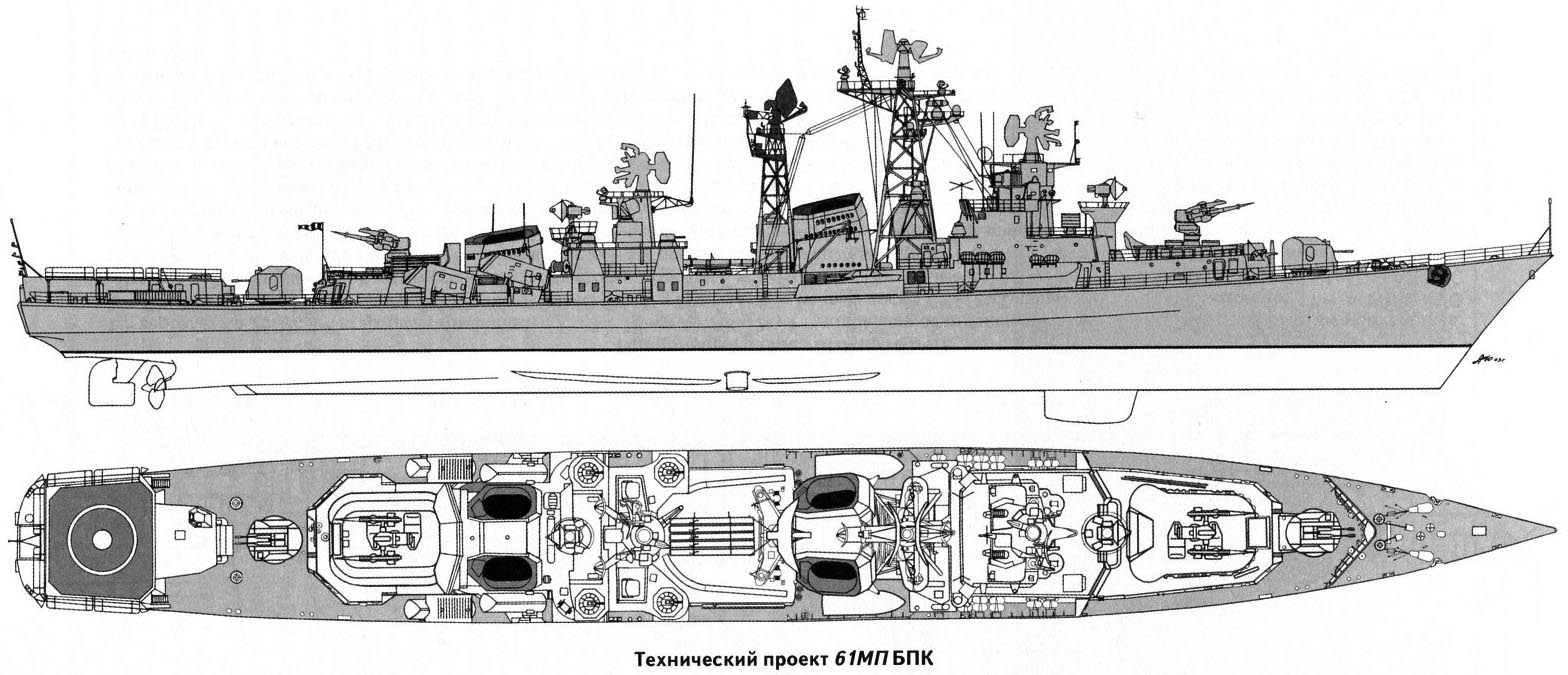
In 1990, Sposobny was converted into a test ship for testing a new towed sonar array. The modernization was not completed as the collapse of the Soviet Union and by 1993 she was decommissioned.
The last major modernization was under Project 01090, done on 1990-1995 on Smetlivy. Instead of a stern gun and helipad, she had a MNK-300 non-acoustic submarine detection complex installed, complete with a 300-meter VDS towed antenna receiptive to thermal, radiation and noise signals. The RBU-1000 were replaced by two four-launchers X-35 Uran anti-ship missiles (The Russian Harpoon) as well as a new EW suite with the PK-10 and PK-16 jammers relocated near the bridge; new radars and the PKRK control system. Displacement reached 4,700 tons.
Modernization projects 61K (1961), 61 bis (1964) and 61A (1965) stayed as paper projects.
Nikolaev’s Yard manager captain 1st rank Dragunov Genrikh Vasilyevich made a large contribution in the design and acceptance of the Volna anti-aircraft missile systems, other combat complexes and all modernization Projects.
 ORP Warzsawa
ORP Warzsawa
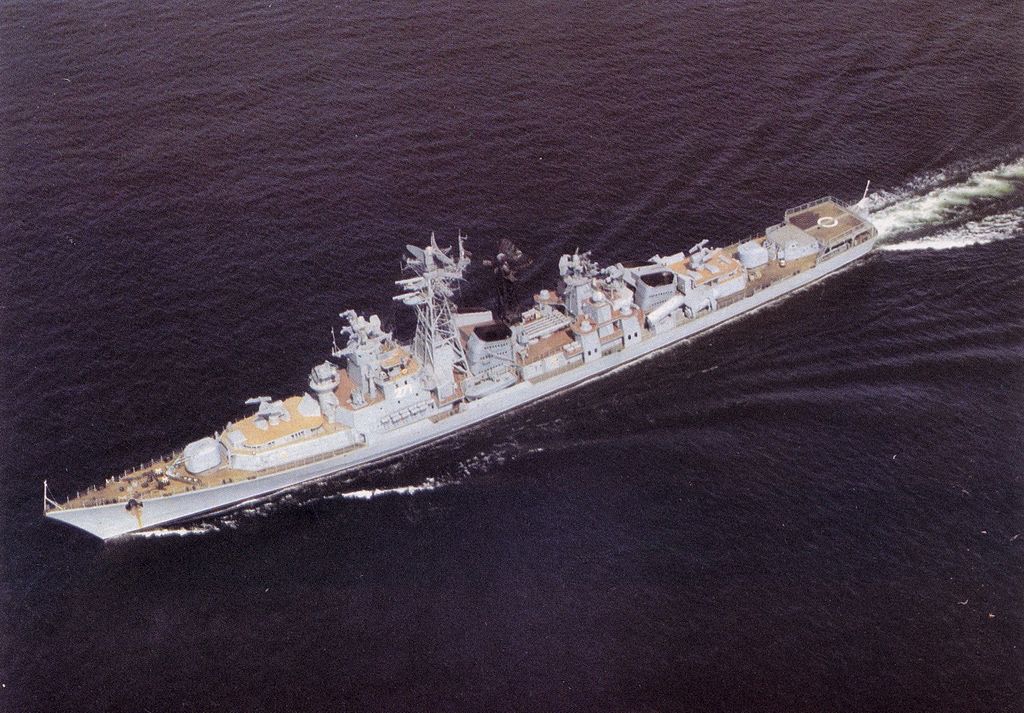
Build at 61 Communards Shipyard and laid down on 15 November 1966 as Smelyi, Launched on 6 February 1968, Commissioned on 27 December 1969, as part of the CKB-53 class (NATO Kashin-class) and among the largest destroyers at 4,950 tonnes. She was used as a multi-purpose vessel with an almost full auto armament. Modernized 1972-1974 to the 61MP standard (NATO Kashin mod) between armament, radar and fire control systems. By 1987 she was leased by Poland as replacement for the previous worn out Warszawa. In 1992-1993 she was permanently transferred in exchange for Soviet debts in Gdynia.
16 years later she was discarded and sold back to USSR and sent to the reserve, sold again for scrap at Gdańsk.
Project 61E
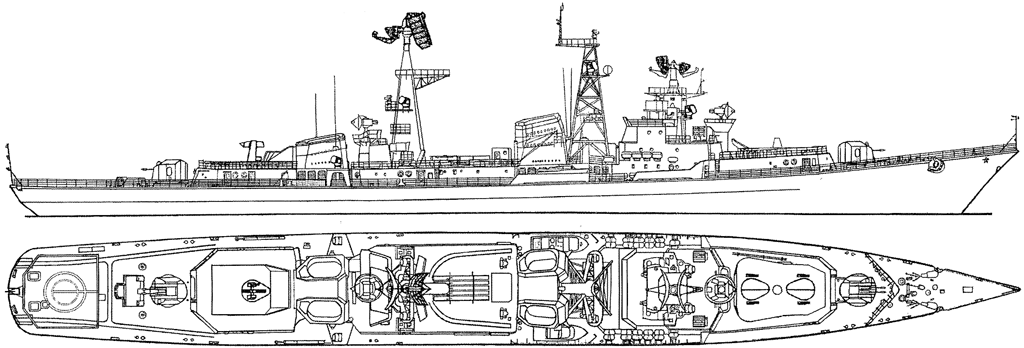
In 1975, Provorny was modernized under Project 61E, having her Volna systems removed, whereas a multi-channel air defense system M-22 Shtil was installed at the stern for testings. In addition, the MR-500 surveillance radar was replaced by the new Fregat-M. At the end of the tests in 1978 it was panned to install two more Shtil air defense systems forward and and modernize four other ships but this was abandoned. Displacement increased to 3,810/4,750 tons. The Shtil air defense system was installed on the Project 956 destroyers (Sovremenny).
 Project 61ME
Project 61ME
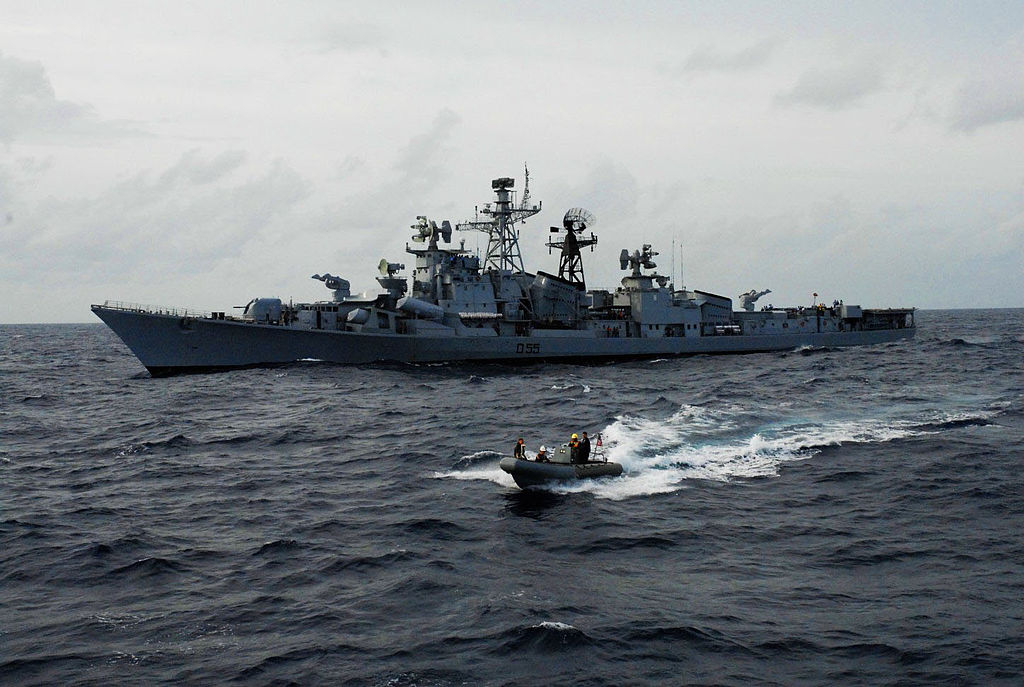
In 1976-1987 under project 61ME, five ships were built for the Indian Navy. During the modernization process the aft 76-mm guns and Turel control system were removed and instead a semi-recessed helicopter hangar was installed, whereas the aft P-15 anti-ship missile launchers were replaced by P-20 missiles, but mounted forward. It was planned to replace the 76-mm AK-726 bow gun mount with a 100-mm AK-100 but it was cancelled. Displacement rosed to 4,025/4,905 tons FL. Project 61ME ships became the first Soviet large missile warships built for a foreign customer.
The Rajput class (or “R” class) were basically Kashin II class destroyers built in Nikolaiev, USSR between 1979 and 1988. They were the Soviet project 61ME, export version of 61M. Their SSN-2C “Styx” launchers are mounted forward, either side of the SAM. So unlike in modified Soviet units. These Termit SSM are capable to strike at 80km, at Mach 0.9. They are cruse to 1990s standard and sensitive to jamming and flares. Also, the stern turret was eliminated to make room for a hangar and helicopter deck, reached by a ramp. Also for close defence they possessed twin 30 mm CIWS. Started in 1976-82, they were commissioned in 1980-87. These were an important landmark in the Indian Navy as being the first missile destroyers of the Navy, a good fit for the task forces based around INS Vikrant and Viraat. They were split between the eastern and western fleets. They were the first ships in the Indian Navy also to deploy the BrahMos supersonic cruise missile. They underwent a mid-life refit in 2010 with modernization of their electronics. Two MR-104 Rys’ radars, two additional Rashmi radars, the TQN-2 ECM suite, MR-500 Kliver radar with additional two RAWL-02 rada, Planshet-61ME CCS and Thomson CMS-SNF CCS. In 2015, INS Ranvir received a twin forward 76mm OTO-Melara Compact SR and INS Ranvijay received an updated vertical launcher for her BrahMos missile.
A new upgrade is planned for the propulsion system, including the Kaveri Marine Gas Turbine from DRDO, currently in testing phase.
INS Ranjit differed by having two Bharat RAWL (Dutch Signaal LW08) radars working at D-band. On all ships, the MR-310U Angara (“Head Net-C”) was replaced by the Dutch EL/M-2238 STAR and Bharat HUMSA sonar during their major refit. Armament also differed among ships: INS Rajput was given four BrahMos and two SS-N-2D Styx, one Dhanush ballistic missile. Rana and Ranjit had their four original SS-N-2D Styx while Ranvir and Ranvijay they were replaced by BrahMos (aft VLS) and still two SS-N-2D Styx forward.
All four had the same S-125M (SA-N-1) launchers, for and aft, apart Ranvir and Ranvijay which had one and a Barak 1 SAM cell launcher.
All have two 76.2 mm main gun, Rajput and Rana four 30 mm AK-230 CIWS in, Ranjit four 30 mm AK-630M CIWS and Ranvijay two 30 mm AK-630M CIWS in addition.
All four had the same ASW equipment: Single quintuple 533 mm PTA TT, and two RBU-6000 anti-submarine mortars. They are now still all active.
General Assessment
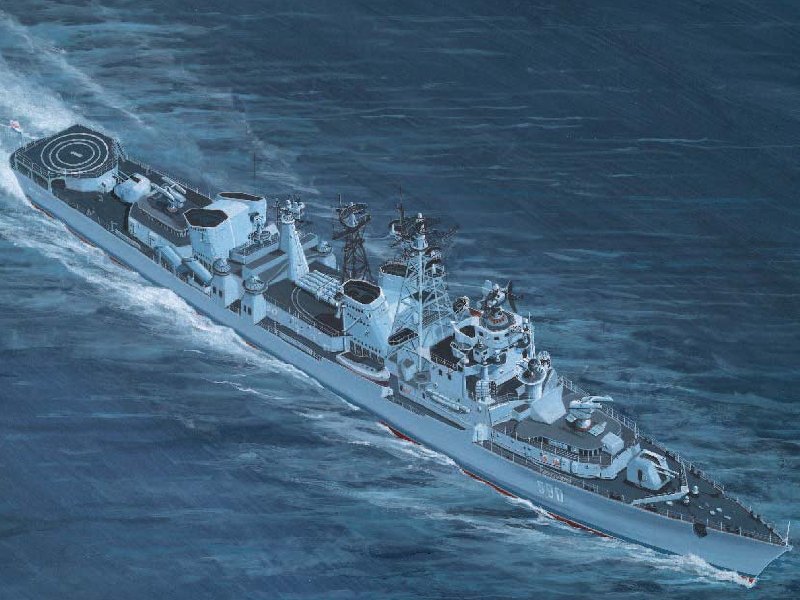
Project 61 ships were a very successful series, representing a significant advance in terms of defensive systems compared to the previous Project 58 Grozny (Kynda class) and the Soviet Union trumpeted the fast it had the world’s first gas turbine powered large units, directly on their main drive and not as auxiliaries. They had twice as many missiles as any previous Soviet ship for fleet defence, while the artillery was located more rationally, and they had no dead angles.
They were often compared in NATO reports to the Farraguts and Charles F. Adams class destroyers, but with the advantage of their gas turbine, presenting many advantages the US destroyers lacked. This was only compensated from the Spruance class onwards.
The Kashins and Adams had comparable anti-aircraft missiles, with two launchers being compensated by the higher reloading speed of the Adams RIM-24 Tartar, and it was longer-range compared to the Volna.
At the same time their anti-submarine ship capability was ladding behind. The ASW launchers were believed superior to the USN’s RUR-4 Weapon Alpha in the US Navy from 1951 as their the rate of fire was better from two up to six times, but in 1960 the RUR-5 ASROC was clearl superior. As a result, the Kashin’s ASW warfare capabilities were soon no longer sufficient against the new generation of US SSNs and SSBNs although this deficiency was partially compensated by the 533-mm torpedo tubes, upgraded regularly with new SET and TEST families of acoustic, homing heavy torpedoes. Still, detection remained closed range.
Project 61 had a powerful close-in ASW defense compared to two triple 324-mm acoustic torpedo banks, no ASWRL but more than compensated by the ASROC capable of 5-16 kilometers with a tactical nuclear warhead if needed.
A significant of the Kashins were their landing pad for a helicopte whereas US destroyers operated under the umbrella of a aircraft carrier group of the anti-submarine formation of frigates carrying deck-based helicopters. But the lack of hangar penalized the Kashins.
In terms of its capabilities against surface/coastal targets, the Charles F. Adams were superior due to their 127-mm guns. It was summup and undertsood in that the Project 61 were more tailored and specialized as anti-submarine defense ships while the American destroyer were a universal escort ships, with extra versatility.
Read More/Src
Books
Gardiner, Robert; Chumbley, Stephen; Budzbon, Przemysław, eds. (1995). Conway’s All the World’s Fighting Ships 1947–1995. Annapolis, Maryland: Naval Institute Press. ISBN 1-55750-132-7.
V.V. Kostrichenko, A.A Prostokishin (В.В.Костриченко, А.А.Простокишин): “Poyushchiye fryegaty”. Bolshiye protivolodochniye korabli proyekta 61 («Поющие фрегаты» Большие противолодочные корабли проекта 61), Morskaya Kollektsya 1/1999
Links
web.archive.org/ ship.bsu.by
russianships.info/
apps.dtic.mil/ NATO declass. report Kashin class 1982
Torpedoes navweaps.com
on trid.trb.org
www.ww2.dk/ Kashin.htm
militarytoday.com
history.navy.mil
militaryperiscope.com/
sakhalianet.x10.mx/
ru.wikipedia.org/
en.wikipedia.org
https://commons.wikimedia.org/
usni.org/ proceedings 2017 one step forward, two steps back
pib.gov.in/
Videos
Model Kits
on scalemates.com
on casematepublishers.com/
3D
 Komsomolets Ukrainy (SKR-25)
Komsomolets Ukrainy (SKR-25)

On November 23, 1964, Komsomolets Ukrainy entered officially Black Sea Fleet service. On February 19, 1966, she was awarded a navy Prize and diploma for excellence in training by the CiC Adm. Gorshkov. From June 5 to June 30, 1967, she sortied tro support Egypt during the Arab-Israeli conflict, with the 5th squadron and by April-May 1970 she took part in “Ocean-70” maneuvers, stopping in Algeria on May 8 – 13, 1970. On August 30, 1974 the destroyer “Votazhny” suffered an explosion and were assisted by Komsomolets Ukrainy.
From May 23, 1977 to August 7, 1979 she had a major overhaul at Nikolaev NyD. In May 1980, she was in Varna, Belarus. In 1981, she made two major deployments in the Mediterranean, from May 22 to July 14 and from August 21 to March 1, 1982 and by December 1981 visited Split in Croatia. In June-July she took part in “Shield-82” exercise, stopping at Burgas and Varna and in 1982, she was drydocked in Tuapse.
In 1982, she made another Mediterranean deployment from October 26 to July 1, 1983, stopping at Tartus in Syria. In 1984, same from February 25 to July 27, and visiting Dubrovnik. She twice was used as radar picket ship in the combat zone off Lebanon. She was used for filiming “Listening in the Compartments” in 1984. In 1985 she took part in Granit-85 exercises. In June 1986 she took part in joint squadron exercises, stopping at Sozopol and Burgas. She stopped in Greece by November, Piraeus), and Yugoslavia, Split as well as Tunisia, Algeria, Turkey and by April 1988 was posted in air defense missions in Tripoli, Libya. On June 24, 1991 she was decommissioned, transferred to reserved and sale. She was known as number 1701 when BU Inkerman by May 3, 1995.
 Soobrazitelny (SKR-44)
Soobrazitelny (SKR-44)
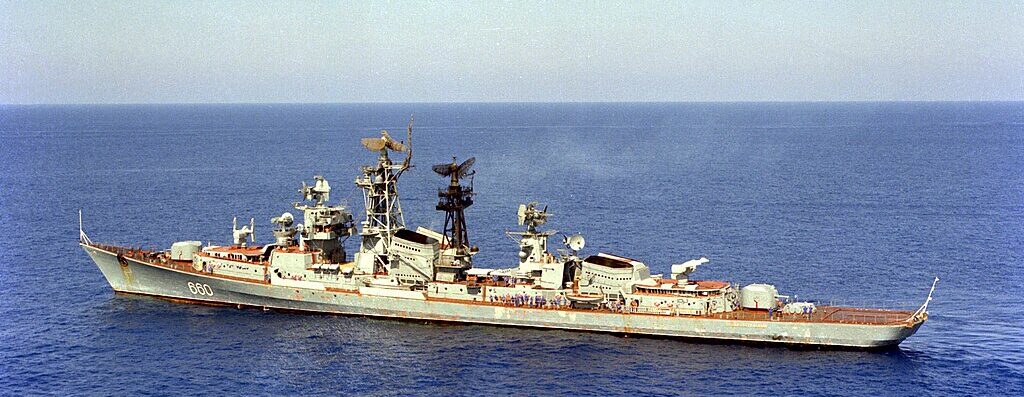
“Astute” was from 61 Communards, Nikolaev (serial number 1702) she was commissioned on November 23, 1963, in the Black Sea Fleet. On June 18-25, 1964, she visited Split. From June 1 to June 31, 1967, she carried out a deployment off Egypt as part of the Arab-Israeli conflict. She would later visit during her Mediterranean deployments Varna, Kotor and Zelenka, Havana, Tunisia, Luanda Conakry (Bissau), Pointe-Noire; Sao Tome and Porto Novo. From October 1, 1976 to November 28, 1978, she had a major overhaul at Sevmorzavod, Sevastopol
On August 6, 1982, she was transferred to the Northern Fleet. She was decommissioned on October 1, 1988, and on July 3, 1992, stricken and sold in 1994, to a private company in India.
Her last commander was captain 3rd rank Murashov E. A. (1984—1986).The head of the medical service from 1977 to 1978, lieutenant of the medical service Alexander Vitalievich Finogeev became a writer celebrity from 2014.
 Provorny (SKR-37)
Provorny (SKR-37)
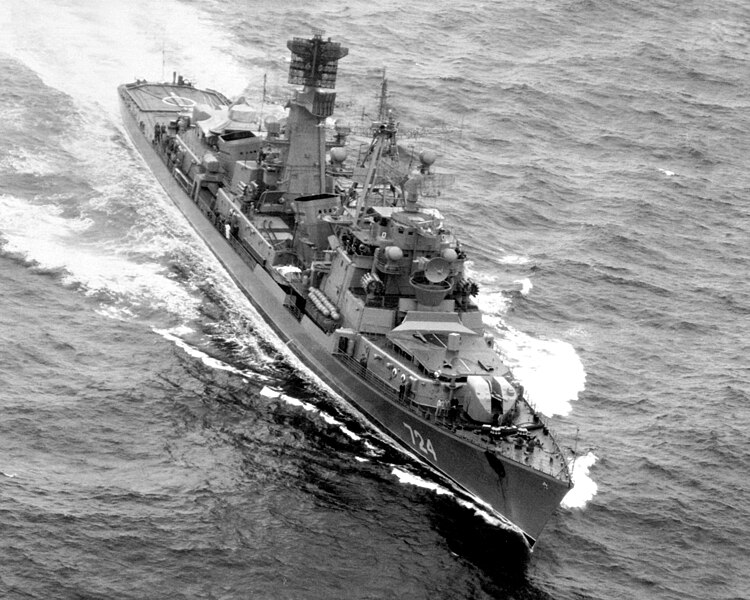
“Prompt” was commissioned on 25 October 1964, assigned to the Black Sea after being built at 61 communards, Nikolaev. She was fully qualified for service by January 22, 1965.
In 1967 and 1973, she twice provided assistance to Egypt and Syria in their wars against Israel. From July 2 to July 7, 1973, she visited Marseille. On March 22, 1974, she had a major overhaul. From August 22, 1973 to August 27, 1974 she was modernized as Project 61E (experimental). SA-N-1 ‘Goa’ replaced by SA-N-7& ‘Gadfly’ SAM launcher.
On December 2, 1977, she started trials, and by 1981 she was assigned to the Northern Fleet, from 1982, 70th ASW brigade, 30th division. From March 1, 1987 to March 21, 1988, she started a new overhauol and modernization, suspended as she approached 25-year and by August 21, 1990 she was decommissoned. On February 18, 1993 was sent to Inkerman, BU. Last commander was Captain 2nd Rank Potvorov V.L.
 Odaryonny
Odaryonny
“Talented” was from Zhdanov Shipyard, she was commissioned on 30 December 1965 assigned to the Northern Fleet. Deployed in search for Korean Airline 007, shot down in 1983. No records.
 Obraztsovy (SKR-2)
Obraztsovy (SKR-2)
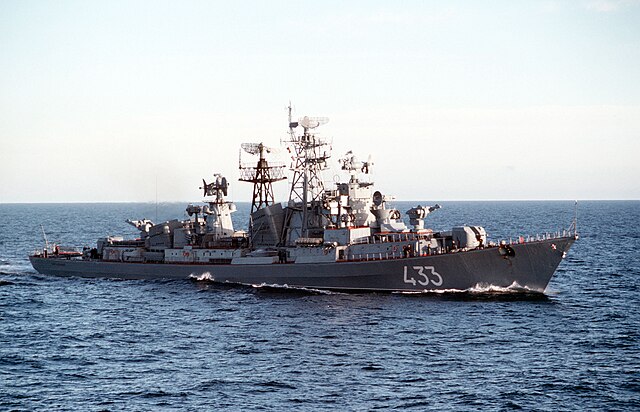
“Exemplary” was commissioned on 20 September 1965, assigned to the Baltic fleet. She was attached to the 128th Missile Ship Brigade, visited Gdynia, Rostock and Warnemünde and in 1970 operatied in the Atlantic Ocean and Mediterranean with the cruiser “Oktyabrskoye Revolutsiya” and the DD Speshnyy, taking part in Okean-70 exercise and visited Cherbourg, operated off the Egyptian coast. In 1971 she operated between the Atlantic and Mediterranean, visited Freetown, Conakry, and was overhauled in 1973 at KHMOLZ, Kronshtadt. In 1974 she was back in operations with Svetlyy and Speshnyy and visited Helsinki in Finland, Rostock, Portsmouth, before a modernization at SRZ-29 Liepaya, visited Gdynia, and in 1980 operated in the Norwegian Sea, North Sea in 1982, Eastern Atlantic 1983, from 88 modernization started SRZ-29 in Liepaya abandoned 1991 due to lack of funding, she was decommissioned in 1993 and BU 1995.
 Otvazhny (ex-Orel)
Otvazhny (ex-Orel)
“Courageous” was built at 61 Communards Shipyard, laid down 10 August 1963, launched 17 November 1964 and completed, commissioned 31 December 1965, assigned to the Black Sea Fleet.
During the Six-Day War (1967) and the Yom Kippur War (1973) she took part in a asquadron showing the flag and on watch, in close proximity and showing commitment and presence not far away from NATO ships. In 1968-69 she was overhauled at the 61st shipyard in Nikolaev, fully modernized. In 1972-1973, she had another eight-month overhaul at Sevastopol. She visited Port Said and Alexandria as well as Split, Bissau, Taranto and Messina and took part in exercises “Yug-71” and “Ocean”. Her last campaign in the Mediterranean was from November 10, 1973 to March 6, 1974 as part of the 70th ASW brigade…
On August 30, 1974 however, under command of captain 2nd rank I.P. Vinnik she took part in exercises in the Black Sea Fleet, preparing to fire anti-aircraft missile in simulated radar interference. The weather saw winds at 10-12 m/s, waves force 3-4 when at 9:58 a.m., a spontaneous launch of the aft-mounted launcher led to a fire and explosion of the fifteen 15 B-601 missiles in the number 8 store. Three other DDs and the rescue ship “Beshtau” arrived to assist with emergency parties. At 10:54 she was towed off Cape Khersones. At 14:47, the fire was raging and hit the depht charge hold, exploding in the 10th ammunition store, also igniting the helicopter kerosene tanks. The powerful explosion destroyed the hull, caused massive flooding ans she sank after 5 hours and 47 minutes battling fire in vain (6 compartments were flooded with 3500 tons). Of 266 crew members, 24 died in the immediate fire, 19 crew members, five cadets.
She was later examined under 130 meters, 28 miles from Sevastopol. It was done from August 31 to September 10, 1974, and salvage of sensitive documentation and hardware done in parts. On November 12, 1974, she was officially stricken, and the wreck blew up at the bottom, after preparations by divers from May to August 1977, with 124 tons of TNT, performed on December 23, 1977.
 Steregushchy
Steregushchy

“Guarding” was built at Zhdanov Shipyard, she was commissioned on 21 December 1966 assigned to the Pacific. The fifth and last ship from the series of “singing frigates” built in Leningrad, on January 7, 1967, was included in the KTOF and made a successful transition to Vladivostok. On March 17 – 24, 1968 and April 3 – 6, 1968 there were official calls at the Indian ports of Madras and Bombay, respectively, as well as on April 17 – 24, 1968, the Somali port of Mogadishu, May 11 – 19, 1968, the Iraqi ports of Umm- Qasr and Basra, May 25 – June 2, 1968 Pakistani port of Karachi, June 5 – 9, 1968 Iranian port of Bandar Abbas, in June 1968 the southern Yemeni port of Aden and July 6 – 11, 1968 the port of Colombo. Then there are numerous military services in the Indian Ocean, which are not made public due to secrecy.
“Steregushchy” was withdrawn from the fleet on December 31, 1978, after which it was mothballed and laid up for fifteen years. On June 30, 1993, he was expelled from the Navy and disarmed. On February 11, 1994, the crew was disbanded, and the Steregushchy hull was sold for cutting to India.
 Krasny Kavkaz
Krasny Kavkaz
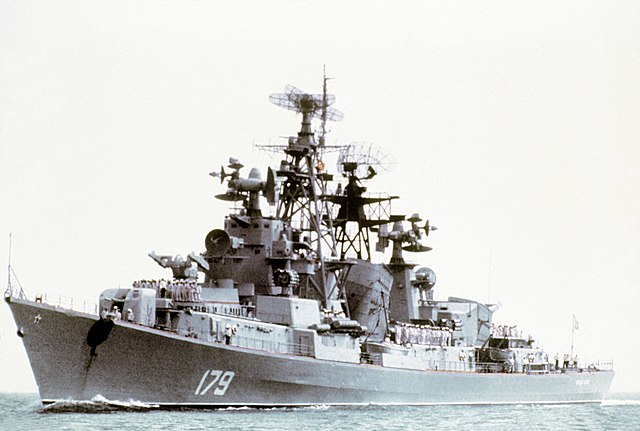
“Red Caucasus” was from 61 Communards Shipyard, she was commissioned on 25 September 1967, assigned to th Black Sea fleet, officially integrated after full qualifications on October 13, 1967, and started Mediterranean sorties with the Arab-Israeli conflicts in 1967 and 1973 and participated in the Yug-71 naval exercises.
From March 1981 to September 1983, she was under major overhaul in Nikolaev. In August 1984, she visited Varna in Bulgaria. She became a host ship when the Greek frigate Limnos visited Odessa, inn a friendly visit. In April-October 1985 she made a long east-west Mediterranean cruise to the Atlantic via a stop in Tunisia. In the fall of 1986, she arrived in Cuba. In the summer of 1985, the crew took part in the film “Valentin and Valentina” maching in formation along the street in Sevastopol. On March 16, 1998, she was stricken and sold for BU.
 Reshitelny
Reshitelny
“Decisive” was commissioned at 30 December 1967, she was assigned to the Black Sea, attached to the 21st Anti-Submarine Warfare Brigade. In 1968 she operated in the Mediterranean, Egyptian coast and Moskva during rea trials. 1969 Mediterranean ops, she visited Varna, refit, then 1971, same, visited Latakiya in Syria. Idem 1973-74 she also shadowed the USS “Iwo Jima” Battle Group with the cruiser Admiral Ushakov and in 1978 visited Messina, Istanbul. 1978-1984 based in Poti, used as training vessel for Indian sailors for its Project 61ME destroyers in construction. On 1.11.89 she was placed in reserve in Sevastopol, decom. 5.97 sold late 1998 sold to a Turkish company for scrapping.
 Strogy
Strogy
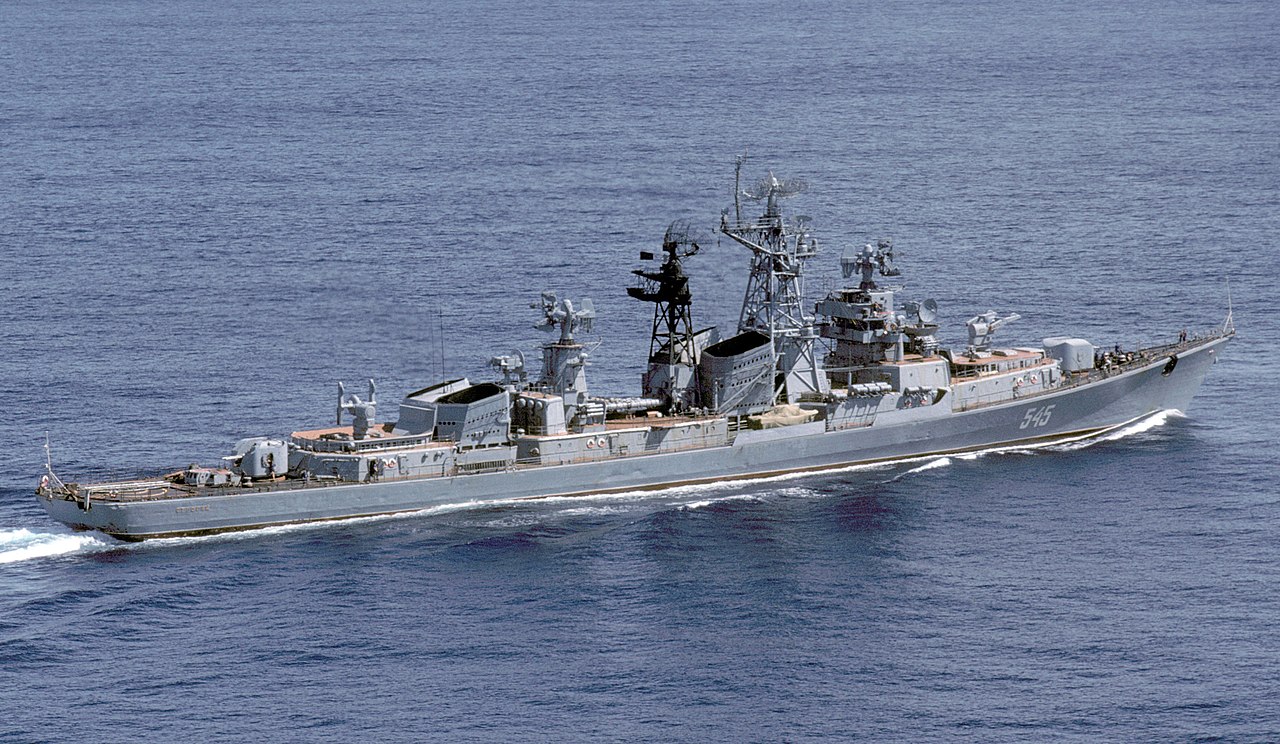
“Strict” was commissioned on 24 December 1968 and assigned to the Pacific fleet. She sailed from Sevastopol to Vladivostok around Africa and through the Indian Ocean, stopping en route at Berbera, Mogadishu, Kismayu, and was attached to the 201st Anti-Submarine Warfare Brigade. She was in operations in the Indian Ocean in 1971-72 stopping at Bombay, Umm-Kasr in Iraq, Port Louis in Mauritius, Colombo, Aden, Massaua, when visited by Emperor Haile Selassie. While in Mogadishu, Somalia in 1972 with the cruise “Varyag” she was visited by Minister of Defence Grechko. In 1972 to 1974 she took part in many Black sea ASW exercises, night mine-laying exercise and in 1974-76 she was modernized at Dalzavod. In 1977 she took part in the exercise “Piton” in the Philippine Sea and until 1978 returned in the Indian Ocean, stopping notably at Victoria, Seychelles and Hai Phong, Vietnam, followed by operations in the South China during the Vietnamese/Chinese conflict. Same in 1984-85 until back to Sevastopol and March 1985 attached to the 183rd ASW Brigade, refitted at Sevmorzavod and returned to to Far East via Maputo, Mozambique. During a command staff exercise she collided with the cruiser “Nikolayev” in the La Perouse Strait and was repaired at Dalzavod in Vladivostok, she was placed in reserve by Nov. 1990 and on 30.6.93 decommissioned, later sold to India for parts, but on the way sank near Singapore in 1995.
 Smetlivy
Smetlivy
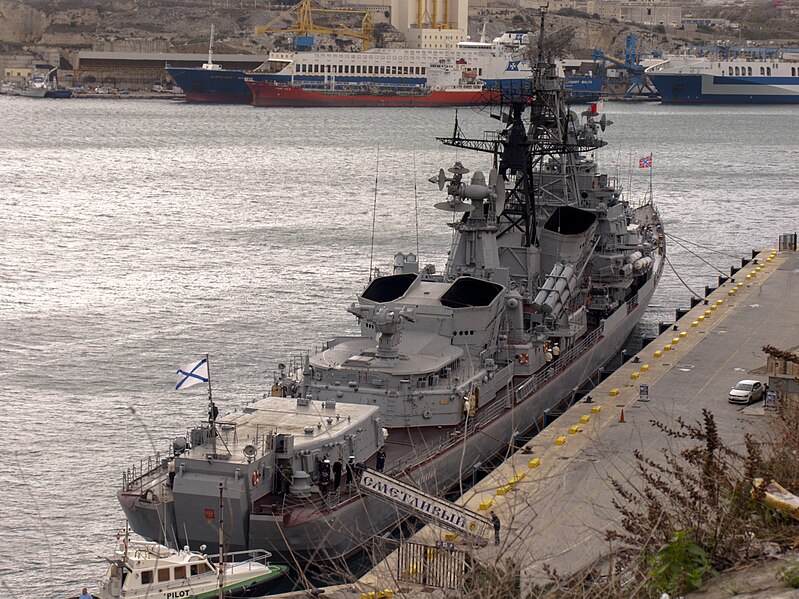
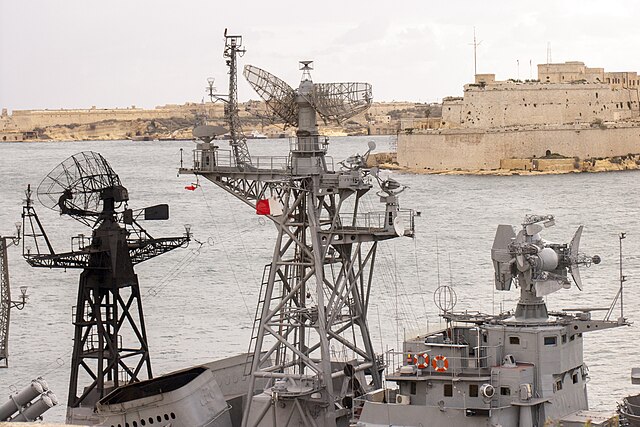

Smetlivyy in Valletta, details.
“Resourceful” was commissioned on 25 September 1969, assigned to the Black Sea. She was attached to the 11th Anti-Submarine Warfare Brigade and operated in the Mediterranean in 1971-1972 also stopping at Casablanca, Latakiya in Syria, Split in Yugoslavia and in 1973 procured support to Egypt, shadowing USS Franklin D. Roosevelt carrier battle group together with the cruiser Murmansk, visited Varna and with Leningrad and Skoryy she took part in mine clearing operations in the Suez-Canal with Ka-25BSh helicopters. She sailing around Africa via Berbera in Somalia by 1974 and visuted Port Louis, Mauritius, Malabo in Equatorial Guinea, Dakar in Senegal before a modernization between 1976 to 1977 at the Sevmorzavod. In 1978 to 1986 she made seven Mediterranean cruisers. In 1987-88 she was modernization as a Project 01090 at Sevmorzavod, Sevastopol, served in the Arabian Sea and Indian Ocean with Moskva. She was modernized in the mid 1990s with eight SS-N-25 ‘Switchblade’ launchers, Decommissioned in 2020, opened as a Museum in 2021.
 Krasny Krym
Krasny Krym
“Red Crimea” was commissioned on 15 October 1970 she was assigned to the Black Sea. She was attached to the 11th Anti-Submarine Warfare Brigade and in 1971 operated off the Egyptian coast, then Indian Ocean, 1972 off the Egyptian coast, 1973 West Mediterranean and shadowing the USS John F. Kennedy battlegroup with the cruiser Admiral Golovko. In 1974 she took part in celebrations as Novorossiysk became a “Hero City” and she was visited by General Secretary Brezhnev. 1975 she visited Toulon together with the cruiser Zhdanov and between 1976 and 1978 conducted three Mediterranean cruises, stopping in Split, Constanza. From 1978 to 1983 she was under modernization at Sevmorzavod Yard. In 1984 she took part in mine clearing operations in the Red Sea off Yemen and Ethiopia with the Leningrad and support vessels. She visited Aden and in 1985 Tunis, in 1990 she visited Taranto and was decommissioned in 1993 and scrapped in 1996.
 Sposobny
Sposobny
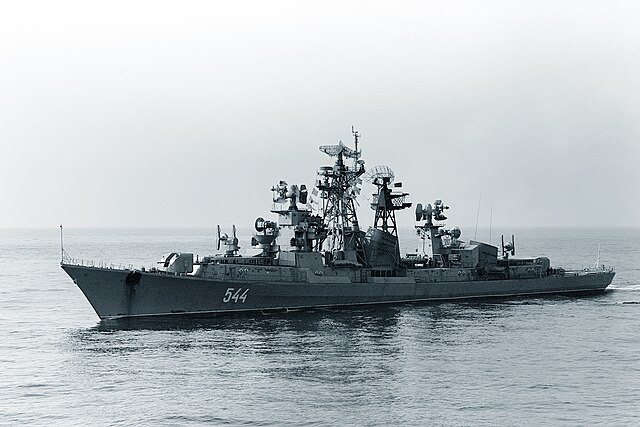
“Capable” was commissioned on 25 September 1971, assigned to the Pacific fleet, she departed Sevastopol under Captain 3rd rank G. Kudryavtsev on 15 February 1972, passed the Cape of Good Hope to the Pacific Fleet, Vladivostok, arriving on on 26 August, assigned to the 175th Missile Ship Brigade, 10th Operational Squadron. She sortied woth the command ship Admiral Senyavin under Kontr-admiral Vladimir Maslov to Port Louis in Mauritius and Bombay in February 1974. Later she sortied with a detachment with the Udaloy-class Gnevny and tanker Ilim under Kontr-admiral Vladimir Varganov. She visited Vancouver, Canada in August 1976, opened to public as part as an exchange program reciprocated visit of Canadian ships to Leningrad, a first since 1944. She later operated with the Admiral Senyavin, cruisers Vasily Chapayev and Admiral Fokin, Strogy and Bozbuzhdenny, frigate Razyashchiy off Vietnam (Sino-Vietnamese War) in March 1979. They intercepted Chinese battlefield communications, passed them on to Vietnamese forces.
She was transferred to the 201st ASW Brigade in 1982, and twice operated in the Sea of Japan tracking USN ships. In June 1983 she sortied with the 8th Operational squadron under Kontr-admiral Gennady Semyonov, visited Colombo, operated in the South China Sea, Indian Ocean 1985 (awared an excellent rating for her performance).
On 16 July 1987, she was temporarily transferred to the Black Sea Fleet. 30 July she was overhaul at Sevastopol as prototype for Project 01090, then transferred to the Northern Fleet after the modernizaiton was changed for Project 01091. Received an experimental non-acoustic submarine detection equipment, modernization 70% with the the fall of the Soviet Union.
Not completed, 29 October 1992 she stayed in the Black Sea Fleet, remained under Russian control. Decomm. 6 January 1993, transferred to Sevastopol, North Dock, Yuzhnaya Bay, stripped by 20 November, crew disbanded, sold to an Indian company for scrapping, towed from Sevastopol on 2 April 1995.
 Skory
Skory
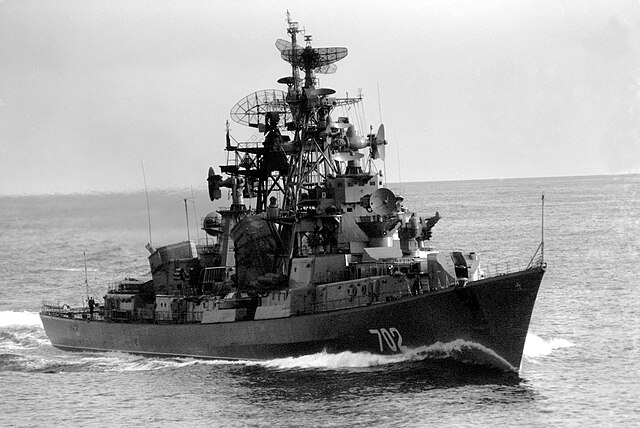
“Fast” was commissioned on 23 September 1972, she was assigned to the Black Sea fleet. She was assigned to the 150th Missile Ship Brigade and started missions from 1973 in the Mediterranean, and Egyptian waters, she also visited Split, with “Nikolayev” and “Smetlivyy” and operated until late 1974 off Egypt with the helicopter cruiser “Leningrad”, and her sister “Smetlivyy”, supplied by the fleet tanker “Boris Chilikin”, they notably cleared mines in the Suez-Canal, Skoriy operating a Ka-25BSh, the rest provided by the helicopter carrier being Mi-8BT helicopters. Later she visited Port Louis in Mauritius, Dakar in Senegal and returned to the Mediterranean, visiting in 1978 visited Piraeus in Greece? She had a major overhaul from 1982 to 1985 and modernization Sevmorzavod Yard. In 1991 with her sister Bezukorinennyy she the carrier “Admiral Kuznetsov” from Sevastopol to the Gibraltar but on 21.8.92 she suffered a severe engine room fire. She was repaired and attached from Dec. 1994 to the 21st Anti-Submarine Warfare Brigade but during an April 1995 exercise, the engines failed and she was again repaired but placed in reserve in 1995, modernization was cancelled and after some with the 11th Anti-Submarine Warfare Brigade she was decommissioned in 1997, scrapped in 1998.
 Ognevoy (SKR-31, 1963) Project 61MP
Ognevoy (SKR-31, 1963) Project 61MP
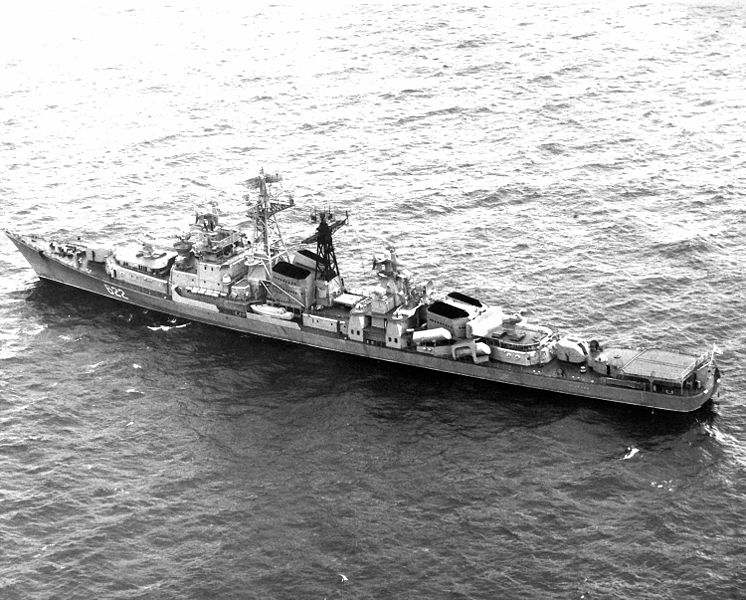
“Fiery” was from Zhdanov Shipyard in Leningrad, commissioned on 31 December 1964. She started operations from January 21, 1965 until assigned to the Northern Fleet. In 1970-1971 she made a campaign to Cuba. In 1971 she made a passage to Baltiysk until 1972, and after modernization, transferred to the Northern Fleet. From August 27 to September 10, she arrived at Severomorsk and performed several Mediterranean deployments in 1983-1984, visited Tartus in 1983; based in Sevastopol, she Annaba in Algeria, took part in the Ocean 83 exercise, OSRUS exercise, then Atlantic 84, escorting the fleet in the North Atlantic. In December-June 1985 she was in Luanda, Angola and by January-June 1986 back in the Mediterranean, stopping at Tobruk. She was decommissioned on October 1989, BU.
 Stroyny
Stroyny

“Slim” was built at 61 Communards Shipyard, commissioned on 15 December 1966. In 1967 she operated between the Mediterranean and Northern Atlantic, and was transferred to the Northern Fleet, 120th Missile Ship Brigade. She helped the submarine “K-3” in the Norwegian Sea and was in 1969 operations, Atlantic-Mediterranean, stopping at Reykjavik, Iceland before a modernization at SRZ-35 Murmansk, resuming 1972 Atlantic operations, visited Havana with the cruiser Murmansk and majing a sortie in the Mediterranean? She had a major overhaul modernization in 1980-81 as a Project 61MP at 61 Kommunar Yard adn resumed Mediterranean ops, with “Okean-83” exercise, ventured in 1985 in the Persian Gulf, with the “Kiev”, and cruiser “Vice-Admiral Drozd” and destroyer “Sovremennyy”, the battle group visited Aden and Dubrovnik as well as the Socrota Island in Yemen. In 1988 she was back in the Atlantic Ocean with Sovremennyy and tracked NATO exercise “Northern Wedding-78” Until fall 1989 she operated on the eastern Atlantic and from Jan 1990 she was relegated to reserve at Murmansk; She was Decommissioned in 1990, scrapped in 1994
 Slavny
Slavny

“Glorious” was built at Zhdanov Shipyard, commissioned on 30 September 1966. She was attached to the 128th Missile Ship Brigade and in 1966-1971 operated in the Baltic, visited Rostock, Copenhagen, and from 1972 in the Mediterranean, off the Egyptian and Syrian coastlines. In 1973-75 she was repaired and modernized as a Project 61MP at Zhdanov yard Leningrad and in 1977-78 operated in the Central Atlantic and Caribbean Sea with “Bodryy” and “Silnyy, the sub “K-22” and tanker “Olekma”, rescue ship “Aldan” for Soviet/Cuban exercises, staying at Havana. In 1985-86 she agains operated on the Atlantic-Caribbean with the “Silnyy” again stopped in Havana but when back, visited Gdynia, Szcecin, but from 1989 she was relegated to the reserve at Baltiysk with her planned modernization in 1991 in Liepaya cancelled. Decommissioned in 1991, on 31.12.91 she sank at Baltiysk harbour. In 1998 raised and scrapped.
 Smyshlyony
Smyshlyony
“Intelligent” was from 61 Communards Shipyard, she was commissoned on 27 September 1968. She was Decommissioned in 1993, scrapped in 1994.
In April 1972, she visited Casablanca and from March 6 to March 12, 1973, Latakia in Syria. In 1973 she visited Split and took part in the evacuation of Soviet specialists and their families from Syria and Egypt during the Yom Kippur War. She visited Varna and took part in the rescue of her crippled sister “Valiant”. She returned to the shores of Egypt, and cleared mines in the waters of the Suez Canal until October 14, 1974. In 1976-1977 she was overhauled. In 1980 she visited La Goulette, Tunisia, Varna, Split and in 1984-1985 in the Black and Mediterranean Seas she took part in the film “Men’s Anxieties”. From 1970 to 1987, she completed 12 campaigns, with 10 inter-naval exercises over 320,000 miles.
Smetlivy was modernized according under project 01090 in 1987-1995, Sevastopol, seeing the installation of the Uran anti-ship complex, and a new VLS non-acoustic system plus Kaira MNK-300 submarines, new Jamming systems and radars. In 2000, her Uran launchers were removed for trials on a FAC, but back in 2002.
She took part in the second war in Abkhazia in May 1998, used as a communications relay. In April 2000 sge became the flagship of Russian Black Sea Fleet Admiral V.P. Komoyedov, visiting Istanbul. In 2003, she took part in naval exercises in the Indian Ocean with the Indian Navy and Russian Pacific Fleet. In August 2003 she stopped in Mumbai and from August 20 to September 15 with the helicopter cruiser Moskva operated under Vice Admiral V.V. Masorin in international exercises with the Italian destroyer Audace, stopping at La Maddalena, La Spezia, Patras and in 2004, took part in a Russian Black Sea Fleet Mediterranean cruise, stopping at Izmir, Thessaloniki, Taranto, Augusta, Valletta, Mirina. From September 13 to 17, 2004 with “Moskva”, she took part in the Russian-Italian exercises “Ionex-2004” and later “Active Endeavor” and made another cruise under Vice Admiral A. A. Tatarinov.
From February 2006 to March 2007 she had a second overhaul at Novorossiysk, being the oldest Kashinclass ship in service. In 2008 she was back at Novorossiysk and sailed with the cruiser Kerch. From August 8, 2008, she was present for the war in Georgia. During night refueling on August 22, 2008, a pipeline ruptured, fuel entering the gas turbine generator, a fire in the aft engine room started, killing S.S. Nikolenko. On September she independently returned to Sevastopol for repairs. She took part in the Navy Day parade in 2009.
From September 2010 to February 2011, she had her gas turbine engine No. 3 replaced and performed sea trials in March-April 2011, completed with artillery and missile firing.
She famously visited Valletta (Malta) in 2013, generating many photos. In 2011 she took part in the Russian-Italian naval exercise “Ionex-2011” and in 2012, stopped at Tartus in Syria.
In 2013, she operated off Syria, visited Piraeus and took part in “Ioniex-2012”, and later with Moskva, took part in exercises south of the coast of Cyprus.
In 2013-2014 she mlade another deployment in the Mediterranean and from November 4 to 9, 2013, took part in “Ioniex-2013” in the Gulf of Taranto, stopping at Kerkyra, Piraeus and Toulon, covering 22,500 miles in 150 days.
In 2014 he she operated in the eastern Mediterranean making over 16,700 miles in 137 days.
Aegean Sea Incident:
According to the Russian MoD on December 13, 2015, at 9:03 am Moscow time, while at 1000 meters a Turkish fishing ship approached from starboard as she was anchored off Lemnos, and despite numerous attempts to make radio contact nor visual signals and flare, the Turkish vessel closed in to 600 meters and in order to prevent a collision sailors started to open fire with small arms in her direction until she abruptly changed course and continued moving past her at 540 meters. The Turkish version reported by Pacha Muzaffer Gecici (captain) was that he was fishing in international waters off Lesbos, and set off its usual route to unload the catch on Gokceada while Russian ships were posted along the route. It seems nobody in the crew noticed warnings shots nor paid attention to the presence of the Russian destroyer, until informed by a shore station that a Russian ship was firing on them.
In 2015 she was overhauled at the floating dock PD-30, 13th Black Sea Fleet ship repair plant. She had satcom installed, the Centaurus-NM3 system. After trialls and qualif. she visited Corfu in 2015. Under supervision as flagship, Rear Admiral Orekhovsky, by September 2015 she visited Greece and Syria, was in fleet exercises with the Syrian Navy. She visited Patras, receiving relics of St. Andrew (donated to the Black Sea Fleet). She took part in the forum “Russian Week in the Ionian Islands”, betwene Corfou, Lefkada with the Moskva, Ladny, Pytlivy, making exercises off Syria. In 2016 she visited Limassol in Cypru and took part later in the 71st ww2 victory anniversary.
She took part in exercises with Admiral Grigorovich in 2016 and passed the Dardanelles in June back to the Black Sea where she shadowed the USN DDG-78 USS Porter before entering Sevastopol on June 12, 2016. August 2016 she received the Auriga 1.2B VSAT satellite communication station. She took part in “Caucasus-2016”. She protected the Russian Federation EEZ in the Karkinitsky Gulf and gas production platforms of Chernomorneftegaz (Odessa and Golitsinsky fields) patrolled in the Odessa Gulf against the Ukrainian Navy.
Later she visited Piraeus (Greece) and in 2016 took part in the 165th anniversary of the Queen of Greece parade. She later took part in the Admiral Kuznetsov CBG over 20,000 miles in 129 days stopping at Tartus and back to Sevastopol on March 6, 2017.
After 2017 exercises in black sea waters, she returned to the Mediterranean as flagship, Vice Admiral Valery Kulikov with the Admiral Grigorovich and Admiral Essen in tactical exercises for convoy operation and life firings.
She protected the 2017 Games in Sochi from June 15 to 24, 2017, patrolled near the Black Sea coast, Caucasus, with Suzdalets, Yeisk and Povorino. She had a short refit from July to November 2017 in the floating dock “PD-30” and 13th ship repair plant, Sevastopol. After trials she shadown the 2nd NATO naval group (HMS Duncan, the Turkish frigates “Gaziantep”, Rom. “Regele Ferdinand”) and US Navy USS Carney. She trained with Admiral Essen and Pytlivy. In April 1918 they sortied in the Mediterranean for 125 days.
In July 2019, Smetlivy shadown NATO ships in Ex. Sea Breeze-2019, Black Sea.
By December 2019 it was decided to extend her service by a major overhaul although there were proposals to turn her into a museum ship in the South Bay, Sevastopol. She was decomm. in early 2020, and by July 11, entered the dry dock of the 13th ship repair plant for conversion into a museum ship, until August 10, 2020, with final work for long-term mooring, stricken August 27, and opened to the public on May 13, 2021 as part of the Patriot Park, Southern Military District.
 ORP Warszawa
ORP Warszawa
She was the ex-Smely (“valiant”) renamed Warsaw, she was commissioned on 27 December 1969. Leased to Poland in 1988, bought by Poland in 1992-1993. Decommissioned in 2003, scrapped in 2005.
During her first combat service from April 3 to May 20, 1970, she visited Varna (Bulgaria, 04.04-06.04) and Alexandria (Egypt, 04.05-09.05).
 Sderzhanny
Sderzhanny
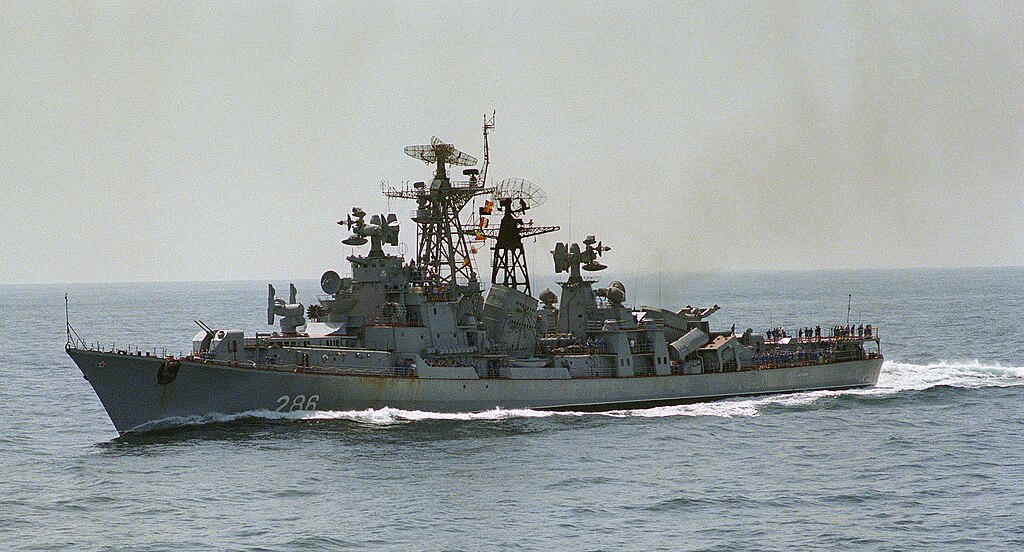
Project 61M ship on 30.12.73; She was attached to the 150th Missile Ship Brigade and in 1974 operated in the Mediterranean, as in 1976, visited Tripoli in Libya and in 1983 operated between the Mediterranean and Atlantic Ocean, escorted the Kiev class “Novorossiysk” from Sevastopol to the North Sea and in 1985-87 was modernized at 61 Kommunar Yard, Sevmorzavod Yard, in 1994-1995 she took part in peacekeeping operations off the Abkhazian coast and in 1994 was attached to the 21st Anti-Submarine Warfare Brigade, then 11th Anti-Submarine Warfare Brigade, until decom. on 27.10.2001 decomissioned sold to a Turkish Co. for scrapping in Aliaga.


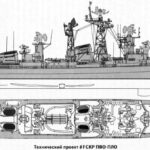
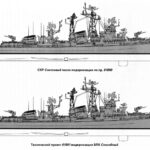
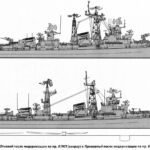

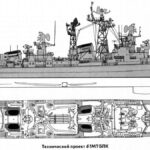
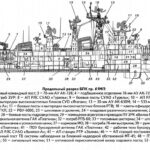
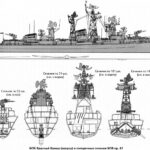
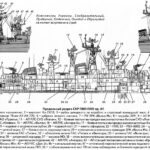
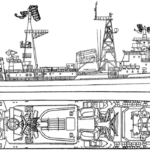

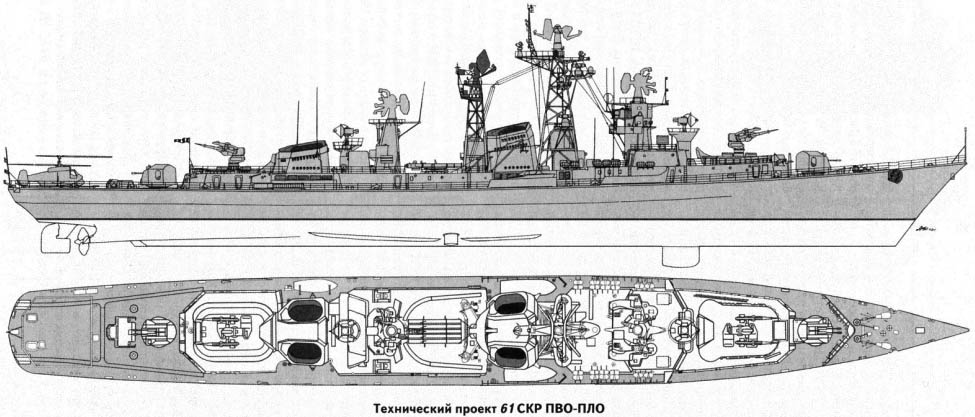
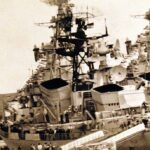
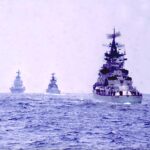
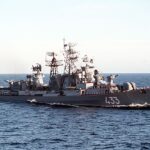
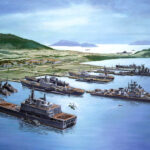
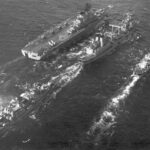
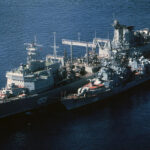

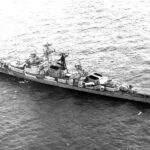
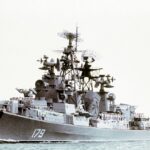
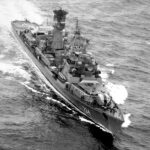
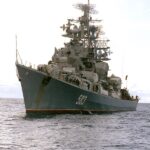
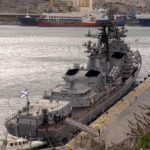
 Latest Facebook Entry -
Latest Facebook Entry -  X(Tweeter) Naval Encyclopedia's deck archive
X(Tweeter) Naval Encyclopedia's deck archive Instagram (@navalencyc)
Instagram (@navalencyc)





 French Navy
French Navy Royal Navy
Royal Navy Russian Navy
Russian Navy Armada Espanola
Armada Espanola Austrian Navy
Austrian Navy K.u.K. Kriegsmarine
K.u.K. Kriegsmarine Dansk Marine
Dansk Marine Nautiko Hellenon
Nautiko Hellenon Koninklije Marine 1870
Koninklije Marine 1870 Marinha do Brasil
Marinha do Brasil Osmanlı Donanması
Osmanlı Donanması Marina Do Peru
Marina Do Peru Marinha do Portugal
Marinha do Portugal Regia Marina 1870
Regia Marina 1870 Nihhon Kaigun 1870
Nihhon Kaigun 1870 Preußische Marine 1870
Preußische Marine 1870 Russkiy Flot 1870
Russkiy Flot 1870 Svenska marinen
Svenska marinen Søværnet
Søværnet Union Navy
Union Navy Confederate Navy
Confederate Navy Armada de Argentina
Armada de Argentina Imperial Chinese Navy
Imperial Chinese Navy Marinha do Portugal
Marinha do Portugal Mexico
Mexico Kaiserliche Marine
Kaiserliche Marine 1898 US Navy
1898 US Navy Sovietskiy Flot
Sovietskiy Flot Royal Canadian Navy
Royal Canadian Navy Royal Australian Navy
Royal Australian Navy RNZN Fleet
RNZN Fleet Chinese Navy 1937
Chinese Navy 1937 Kriegsmarine
Kriegsmarine Chilean Navy
Chilean Navy Danish Navy
Danish Navy Finnish Navy
Finnish Navy Hellenic Navy
Hellenic Navy Polish Navy
Polish Navy Romanian Navy
Romanian Navy Turkish Navy
Turkish Navy Royal Yugoslav Navy
Royal Yugoslav Navy Royal Thai Navy
Royal Thai Navy Minor Navies
Minor Navies Albania
Albania Austria
Austria Belgium
Belgium Columbia
Columbia Costa Rica
Costa Rica Cuba
Cuba Czechoslovakia
Czechoslovakia Dominican Republic
Dominican Republic Haiti
Haiti Hungary
Hungary Honduras
Honduras Estonia
Estonia Iceland
Iceland Eire
Eire Equador
Equador Iran
Iran Iraq
Iraq Latvia
Latvia Liberia
Liberia Lithuania
Lithuania Mandchukuo
Mandchukuo Morocco
Morocco Nicaragua
Nicaragua Persia
Persia San Salvador
San Salvador Sarawak
Sarawak Uruguay
Uruguay Venezuela
Venezuela Zanzibar
Zanzibar Warsaw Pact Navies
Warsaw Pact Navies Bulgaria
Bulgaria Hungary
Hungary

 Bundesmarine
Bundesmarine Dutch Navy
Dutch Navy Hellenic Navy
Hellenic Navy Marina Militare
Marina Militare Yugoslav Navy
Yugoslav Navy Chinese Navy
Chinese Navy Indian Navy
Indian Navy Indonesian Navy
Indonesian Navy JMSDF
JMSDF North Korean Navy
North Korean Navy Pakistani Navy
Pakistani Navy Philippines Navy
Philippines Navy ROKN
ROKN Rep. of Singapore Navy
Rep. of Singapore Navy Taiwanese Navy
Taiwanese Navy IDF Navy
IDF Navy Saudi Navy
Saudi Navy Royal New Zealand Navy
Royal New Zealand Navy Egyptian Navy
Egyptian Navy South African Navy
South African Navy






























 Ukrainian Navy
Ukrainian Navy dbodesign
dbodesign
Of the Kashin class destroyers in Russia only is surving the solely Smetlivy and she is based in Sevastopol in the Black Sea, but the Rajput class (Indian navy) are all in service but highly modified in it’s electronic sensors.
Thanks for the info. Same commentary as for the Belknap. This old article is only a starter that will be expanded and updated in the future
Cheers